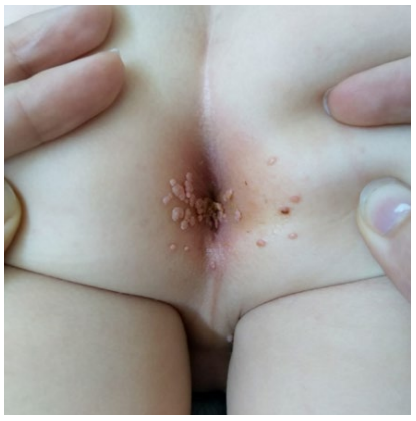Condylomata acuminata in childhood
A three-years-old male child was referred for a pediatric consultation due to perianal lesions noted 4 months prior evaluation, associated with constipation. Perianal skin-colored verrucous papules with approximately 1 to 5 mm diameter were noticed, the most exophytic having a cauliflower-like appearance (Fig. 1). Extension to the anal mucosa was evident (Fig. 2), with no similar lesions observed in other locations. Clinical findings were consistent with condylomata acuminata (anogenital warts). Lesion biopsies confirmed the diagnosis and human papillomavirus (HPV) genotyping identified serotypes 6 and 11 by polymerase chain reaction. Immunodeficiency and other sexually transmitted diseases (human immunodeficiency virus, hepatitis B and C virus, herpes simplex virus and syphilis) were excluded. Active HPV infection on caregivers was excluded and past-treated or untreated infection denied. Multidisciplinary evaluation, with psychological and social assessment, was done and the case reported to the family and criminal court. The child was successfully treated with 8 cycles of weekly applications of topic nitric-zinc complex (Verrutop(), with resolution of both anal and perianal lesions. No recurrence has been observed after two months of follow-up.

Figure 1 Extensive perianal skin-colored verrucous papules, some with cauliflower-like appearance, consistent with anogenital warts
Human papilloma viruses (HPV) are common pathogens associated with a wide range of cutaneous and mucosal infections in childhood, but anogenital warts are rare.1 Transmission can occur sexually but also through non-sexual routes such as perinatal (frequent in children up to 24 months) and direct physical contact (usually cutaneous serotypes).2,3The virus infects primarily epithelial cells through abrasion of the skin or the mucosa, where it can persist as a long-term latent infection (possibly years) until becoming apparent.1,3 Also, it can be transmitted by asymptomatic patients.2 In most individuals, HPV infection remains transient and asymptomatic, resolving within 2 years. Several factors are thought to play a role in the progression of HPV infection, including individual susceptibility, immune status and nutrition.1 Symptomatic children and those with persistent infection should be actively treated. Most treatment strategies studies were conducted in adult populations and its efficacy extrapolated to the pediatric population.2Treatments include topical chemicals/drugs, excisional surgery, cryosurgery, electrosurgery and laser surgery. Nitric-zinc complex is a new topically applied solution containing nitric acid, zinc, copper and organic acids. It has been recently demonstrated to induce a painless caustic effect on ‘‘difficult-to-treat warts’’, including anogenital warts, being effective and well tolerated on adults4 and, therefore, a probably good option for children’s treatment, as seen in our case. Anogenital warts represent an issue with legal and clinical implications and the possibility of sexual abuse should be considered in all cases.1-3,5
















